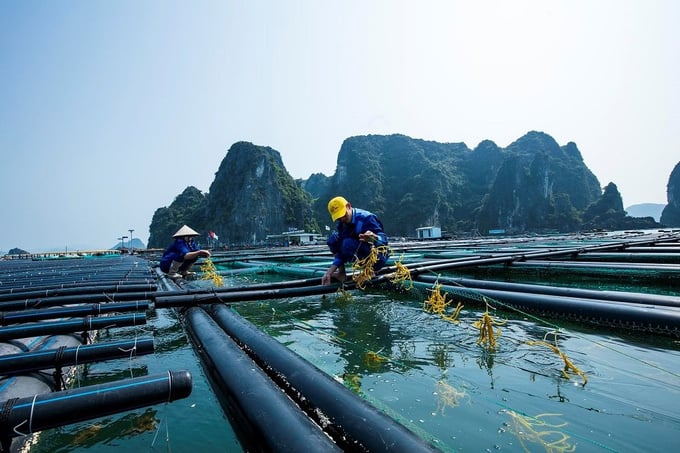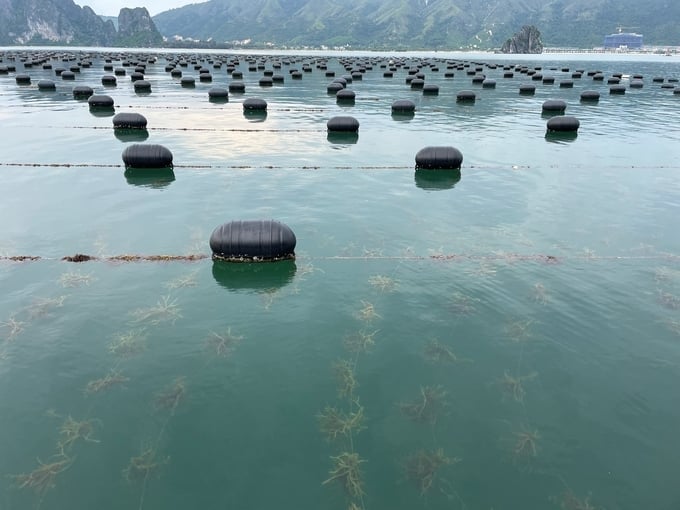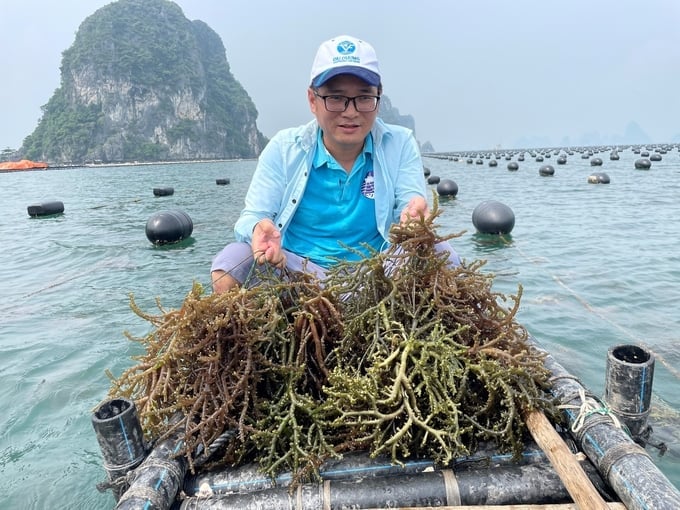May 28, 2025 | 11:55 GMT +7
May 28, 2025 | 11:55 GMT +7
Hotline: 0913.378.918
May 28, 2025 | 11:55 GMT +7
Hotline: 0913.378.918

Elkhorn sea moss farming in Van Don district, Quang Ninh province. Photo: Dinh Muoi.
Elkhorn sea moss is a tropical seaweed species native to the Asian seas, the Pacific Ocean, and particularly the Southeast Asian region. This seaweed species boasts high economic value and can be processed into various forms of instant food product, either from fresh or dried seaweed. However, its most significant value lies in the special chemical compound named carrageenan.
Introduced into Vietnam from the Philippines in 1993, elkhorn sea moss underwent an experimental farming period in Nha Trang city. The sea moss was subsequently propagated to other provinces nationwide, including Binh Dinh, Quang Nam, Thua Thien - Hue, Ninh Thuan, Binh Thuan, Ba Ria - Vung Tau, Kien Giang, etc.
Between the years 1996 and 1997, elkhorn sea moss was also experimentally farmed in Quang Ninh province and Hai Phong city in Northern Vietnam. However, due to its relatively low effectiveness, the farming of elkhorn sea moss has seen limited replication throughout the country.
With the aim of gathering comprehensive data for the development of a draft technical proposal for coastal residents to engage in elkhorn sea moss farming, thereby creating a source of sea moss materials in the Northern provinces of Vietnam, the Research Institute for Marine Fisheries collaborated with local businesses to implement experimental techniques for the commercial farming of elkhorn sea moss in Quang Ninh province.

Elkhorn sea moss brings substantial economic value to farmers and health benefits to consumers. Photo: Dinh Muoi.
The experimental elkhorn sea moss farming site is located in the aquaculture area surrounding Phat Co Island, Ha Long commune, Van Don district. Accordingly, the experimental site is divided into a net cage farming area, an inner rope farming area, and an outer rope farming area.
Following a 42-day experimental farming cycle, spanning from the seeding phase to harvest, the elkhorn sea moss grown in Van Don district exhibited relatively stable growth. Notably, sea moss cultivated in the net cage farming area exhibited slower growth and suffered from high mortality rate due to high water temperature. On the other hand, sea moss grown in the remaining farming areas exhibited consistent growth and development.
Although the findings obtained from the elkhorn sea moss samples in Van Don are marginally lower compared to those documented in prior publications concerning the composition and quality of farmed sea moss in Nha Trang or Ninh Thuan, they meet Vietnam's standards for commercial sea moss in carrageenan production.
According to the Research Institute for Marine Fisheries, as a nutrient-producing seaweed species, elkhorn sea moss is easier to farm at lower costs compared to other species of seaweed. Furthermore, the sea moss also features the ability to grow rapidly, doubling its biomass within 15 days. As a result, elkhorn sea moss can be farmed on a large scale for high yields in coastal areas.

The experimental sea moss farming results conducted by the Research Institute for Marine Fisheries in Van Don district have yielded positive results and exhibited the potential for replication. Photo: Dinh Muoi.
Elkhorn sea moss is commercially farmed in over 20 countries globablly, spanning from tropical to subtropical regions. In Vietnam, Elkhorn sea moss is considered a highly effective aquaculture subject, creating employment opportunities and supplementary income for coastal communities. Additionally, the commercial farming of elkhorn sea moss positively contributes to ecological balance and improves water quality.
"Elkhorn sea moss contains polysaccharides with freeze-forming and adhesive properties, which is widely utilized in various industries, including pharmaceuticals and food. Furthermore, elkhorn sea moss has the potential can be used raw material in ethanol production and agricultural fertilizers. In the past, the extraction of carrageenan relied heavily on natural seaweed sources. However, these natural resources are at risk of depletion due to overexploitation. As a result, the need for farming this seaweed species has become increasingly critical," stated Mr. Do Anh Duy, Deputy Head of the Department of Science at the Research Institute for Marine Fisheries.
In practice, elkhorn sea moss farmers can quickly recover their investment capital due to low input costs and high output profits. Namely, initial investment costs for elkhorn sea moss farming are lower compared to other aquaculture subjects. The sea moss's growth period lasts from three to five months, and the product can be processed immediately after harvesting.
Notably, multiple harvests can be achieved in a year with favorable water environments and an abundant source of nutrients. Farmed sea moss produts possess substantially high economic value. Namely, 80% of the farmed products are exported to demanding markets around the world such as Europe, Japan, South Korea. Fresh sea moss is currently priced at 100,000 Vietnamese dong per kilogram on the market whereas dried sea moss is priced between 300,000 and 500,000 Vietnamese dong per kilogram.

Officers from the Research Institute for Marine Fisheries inspecting the experimental elkhorn sea moss farming model on Phat Co Island, Ha Long commune, Van Don district. Photo: Dinh Muoi.
Mr. Nguyen Sy Binh is a pioneering seaweed farmer in Van Don district, who started with only five kilograms of seed. Accordingly, one hectare of his farming area currently yields an average of 70 to 100 tons of elkhorn sea moss per year.
With a market price of approximately 10,000 Vietnamese dong per kilogram, and a farming area of at least 10 hectares, Mr. Nguyen Sy Binh is generating a substantial annual income stream from elkhorn sea moss farming. He aims to expand the sea moss farming area in combination with mussel farming to improve water environments and supply elkhorn sea moss to the market.
The numerous benefits of elkhorn sea moss including economic value for farmers, environmental improvements, and health benefits for consumers, have led to the widespread adoption of the elkhorn sea moss farming model. However, special technical guidelines for this farming practice has not been fully established.
Consequently, the completion and transfer of research findings from the Research Institute for Marine Fisheries present a valuable opportunity for elkhorn sea moss farmers nationwide, in response to the current scarcity of input sources for processing and trading companies. Consequently, farmers can establish a stable supply in service of both the domestic and international markets
Elkhorn sea moss can be farmed in various aquatic environments, including ponds, bays, intertidal zones, open sea areas, and islands. Farmers currently utilize three primary models: farming on platforms within net cages, farming in intertidal areas and semi-open bays, and farming in ponds. The pond farming model is relatively simple with low initial investment costs and proportionately low productivity. The net cage farming model requires a considerable initial investment but mitigates various issues including consumption by local fish populations, or breakage due to strong waves. As a result the net cage farming model is suitable for maintaining seaweed seedlings during unfavorable seasons for subsequent planting. The intertidal and semi-open bay farming model offers high productivity with moderate initial investment costs. However, this model is susceptible to consumption by local fish populations, necessitating farming on a large scale.
Translated by Nguyen Hai Long
/2025/05/25/4127-3-073637_820.jpg)
(VAN) Thanks to the promotion from an FAO-implemented project, vegetable production in greenhouses in Moc Chau has seen strong development, from 1.5 hectares in 2021 to nearly 50 hectares in 2024.

(VAN) FAO has recently supported USD 140,000 to implement the project 'Risk mitigation human-animal interface risks through disease control initiatives in pig farming.'

(VAN) The People's Committee of Tra Vinh province has approved an adjustment to the investment policy for the Green Hydrogen Plant project, increasing its area to approximately 52.76 hectares.
![Reducing emissions from rice fields: [2] Farmers’ commitment to the soil](https://t.ex-cdn.com/nongnghiepmoitruong.vn/608w/files/news/2025/05/05/dsc08881jpg-nongnghiep-140632.jpg)
(VAN) Clean rice cultivation model in Thuong Tan commune, Bac Tan Uyen district, is assisting local residents in achieving sustainable agriculture by substantially reducing costs, increasing productivity, and protecting the environment.

(VAN) At the conference to disseminate Resolution No. 68, AgriS introduced its digital agricultural ecosystem and reaffirmed its commitment to accompanying the Government in promoting private sector development and sustainable agriculture.

(VAN) 'Blue Ocean - Blue Foods' initiative is designed to restore marine ecosystems and establish sustainable livelihoods for local communities by cultivating a minimum of 1,000 hectares of cottonii seaweed in the first three years.
/2025/05/21/4642-3-112707_603.jpg)
(VAN) The V-SCOPE project has made direct contributions to three out of six pillars of the Comprehensive Strategic Partnership between Vietnam and Australia.